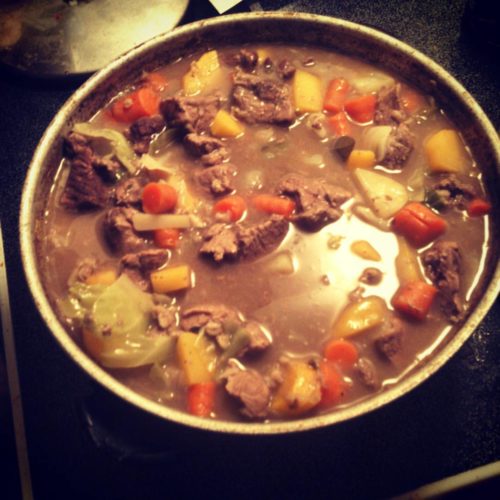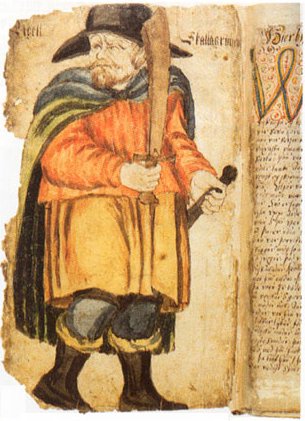
Nothing smells quite like cutting a rutabaga. There’s a small acrid tinge to the air when the knife bites into the yellow flesh; even poor rutabagas like these, which seem to have sat on the grocer’s shelf too long, their stiff hulls gone soft, release that sharp scent in the cutting. It’s the sign that I have cut down to the sweet part of the vegetable, the part to be kept and eaten. I discard the outer skin and chop the rest into cubes. Potatoes and carrots and onions and cabbage will follow the rutabagas onto the cutting board, but I eat these things all the time. The rutabagas, on the other hand, are special. They only come home with me in the winter, when it’s time to make kjötsúpa.

Kjötsúpa, the best of all possible stews. [Photo Credit: Eric Scott.]
I’ve made a pot of kjötsúpa — which is simply Icelandic for “meat stew” — every December for the past four years. I invite over the medievalists from my university, who sometimes bring treats inspired by the middle ages (and sometimes cheesecake). We eat together, unwind from the semester, complain about grading finals and writing seminar papers; warm food and commiseration, the oldest form of human bonding. It’s the only holiday tradition I’ve made for myself as an adult, having grown past many of the childhood staples of Yule and Christmas and having as yet no children of my own to pass them onto. While the party inevitably takes on Christmas overtones — it’s hard for any December gathering to avoid — it’s not actually that kind of party at all. I hold it on Dec. 9, which some Heathen decided (arbitrarily, as best as I can tell) was the day of remembrance for Egill Skallagrimsson, my beloved skaldic hero.
When I came back to graduate school in 2013, it was a homecoming, a return to many things I thought I had finished with. The academy itself, for starters, which I thought I had left for good after my master’s degree, but medieval studies in particular, which I thought I was done with after I finished my undergraduate degree; I had applied to programs in both medieval studies and creative writing, and I went with a writing program. When I started my doctorate at the University of Missouri, I found myself back in not only writing workshops, but medieval studies courses too: Old English, the history of the Viking Age. I reread Egill’s saga, read Njála and Gisla for the first time. I found a light in my eyes I thought had gone out, a part of my wonder that I had forgotten. Perhaps that’s melodramatic, but it’s true. I made my first pot of kjötsúpa to celebrate that. There was a terrible snowstorm that first year, and only three people made it to my house, but that didn’t matter: this was a thing I wanted to keep doing, a winter ritual, to remember not just Egill, but what his saga gave to me.

Egill Skallagrimsson, from a 17th century Icelandic manuscript of Egils saga. [Public Domain]
And I am scared too, of course. I wake up some mornings and think, you picked a hell of a time to become an activist. Usually my better spirits respond: it’s times like this when we need activists. Usually that’s enough to get me out of bed. But not always.
The kjötsúpa, however: it helps. There’s the meditation in the chopping of the vegetables, solemn gratitude in preparing the lamb, the calm music of the simmer. In this moment, late at night, standing over a burner and a cutting board, there is solace.
And Egill stands behind me, that irascible rogue, with his ugly face and his broad shoulders and his strange brow. He was the product of a dispossessed people, chased off their land by a power-hungry king who was only too happy to turn on even those loyal to him. Egill’s response? He thumbed his nose at that king and the kings that followed after him. Egill had his moments of weakness and fear in the face of the powerful, too, but he responded to them always with his Odin-gifted wits and his stubborn spirit.
He didn’t win the fights he set out to win, always. Certainly the kings of Norway lived long past the time of Egill Skallagrimsson. But I find some comfort in his saga anyway. The fight against power is worth it, even if we lose.
The soup finishes its long simmer; time to let it cool and steep, let the flavors percolate throughout. Tomorrow my friends and I will share it, a cup of warmth and friendship against the sudden cold. If there is a better way to greet the winter, I haven’t found it yet.
* * *
The views and opinions expressed by our diverse panel of columnists and guest writers represent the many diverging perspectives held within the global Pagan, Heathen and polytheist communities, but do not necessarily reflect the views of The Wild Hunt Inc. or its management.
The Wild Hunt is not responsible for links to external content.
To join a conversation on this post:
Visit our The Wild Hunt subreddit! Point your favorite browser to https://www.reddit.com/r/The_Wild_Hunt_News/, then click “JOIN”. Make sure to click the bell, too, to be notified of new articles posted to our subreddit.
This was lovely; thank you!
You are a fabulous storyteller; thank you for sharing this.
My Irish granny made something similar. She’d get lamb necks. I remember because you’d often come across a vertebra at the bottom of the bowl. She’d put a “bone dish” on the table to toss them into. Little disturbing as a child, but the stew was good.
Yes! I remember that from my childhood as well. My mom (We’re slavic) periodically made lamb stew and we’d sometimes find bones at the bottom of a bowl as well.